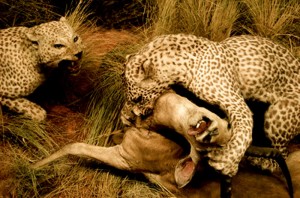Though people generally think of old, dusty museum specimens when they think of taxidermy, the art of mounting animal hides has undergone a tremendous amount of advancement. To understand exactly how far it has come, however, it’s necessary to look back at its origins, first.
 Taxidermy has existed since man began hunting. Archeological evidence of very early taxidermy shows the remains of animals draped over rocks and blocks of wood, which experts speculate may have served either a totemic purpose, or simply served as target practice for novice hunters. Taxidermy that would be recognizable to modern eyes, however, didn’t really begin until the 18th century.
Taxidermy has existed since man began hunting. Archeological evidence of very early taxidermy shows the remains of animals draped over rocks and blocks of wood, which experts speculate may have served either a totemic purpose, or simply served as target practice for novice hunters. Taxidermy that would be recognizable to modern eyes, however, didn’t really begin until the 18th century.
During the 1700s, taxidermy served a dual purpose- it preserved a hunter’s kills, and it saved unusual biological specimens. Explorers like Darwin and Cook needed taxidermy to preserve the new species they found in their travels, since the only way to do so prior to that was to paint or draw the animal, a practice which was fraught with inaccuracy. Unfortunately, most actual taxidermy was done by upholsterers, who simply sewed up the skin and stuffed it with whatever material was available- cotton, wool, rags, sand, sawdust, or something similar. Since stuffing has a tendency to settle, time and gravity made these “stuffed animals” turn out very badly, which is why modern taxidermists prefer the term “mounting” over “stuffing” today. Coupled with the lack of mounting skill back then was the fact that replacing items like eyes, tongues, or noses wasn’t yet common practice. Since these parts don’t react to tanning the same way leather does, they would continue to break down long after the hide was stuffed, making taxidermy a rather poor means of preservation.
In the Victorian era, taxidermists began to take an interest in creating more lifelike mounts. Wooden models were used, which the skin could be stretched over. Though many specimens still required some degree of stuffing, these end products were far more anatomically accurate than the previous “stuffed” animals. Eyes and other soft tissue parts began to be replaced with wood and glass at this point, which meant that some of the best examples of Victorian taxidermy still survive today.
In the mid-1970s, once plastics began becoming more and more abundant, polyurethane foam models began to be used instead of the older, wooden Victorian ones. These had the advantage of being lightweight, and their shape and ability to be sculpted meant that stuffing was no longer required. As a result, modern taxidermy pieces have a much more anatomically correct, natural look than older specimens, and do not shift or decay. Well-done modern taxidermy is rightly considered sculptural wildlife art, and is invaluable for preserving and demonstrating animals in museums, though other artists choose to take their work in a more surrealist or horror direction.
The art of taxidermy has advanced greatly from the first lumpy, stuffed hides from the 18th century. Modern pieces are not only visually stunning, but lifelike and long-lasting, as well.
